Two Pandemics in the Ecuadorian Amazon: COVID-19 and Oil
Indigenous families face dire threat from oil spill
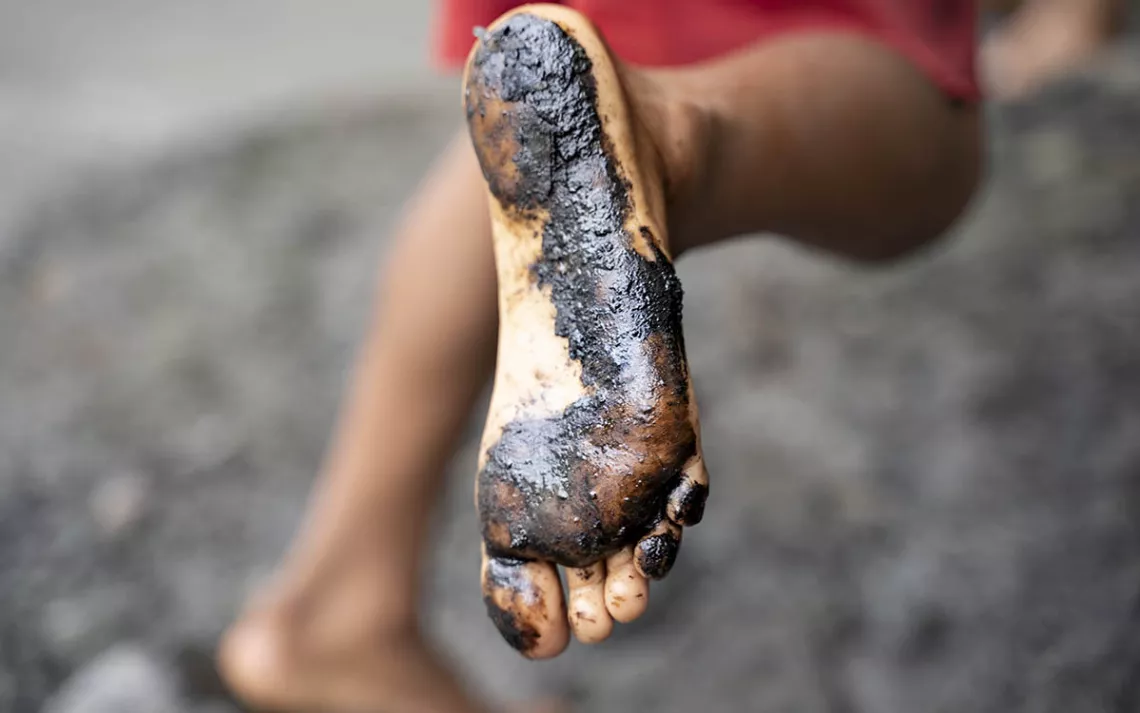
An Indigenous child plays on the crude-oil-stained riverbanks at the community of San Pedro de Río Coca, northern Ecuadorian Amazon, April 18, 2020. | Photos by Telmo Ibarburu
Thousands of Indigenous families in northeastern Ecuador are living a nightmare within a nightmare.
When the COVID-19 pandemic hit, Indigenous people severed connections between their forest communities and the outside world to prevent contagion in their territories. Local sources of food and water became more crucial than ever. Hunting, fishing, and subsistence agriculture are especially important in the northern part of the Ecuadorian Amazon as hunting grounds have been heavily degraded by the oil industry.
Then, on the evening of April 7, two major pipelines running along the banks of the Coca River in the Andean foothills collapsed, releasing an enormous quantity of crude oil into the rushing rapids.
Try to imagine: A deadly airborne virus is sweeping across your country. The government declares a national emergency and tells you to shelter in place. Your home is the forest, and your isolation is your only protection. There are no supermarkets, clinics, or hospitals; for many communities, the nearest ventilator is several days’ journey by canoe and foot. Then, at the worst possible moment, a massive manmade disaster devastates your home and eliminates your only source of food and water.
The Coca River is a key artery in the regional Amazon system. It runs through three national parks that form one of the most biologically rich areas on Earth, eventually merging with the Amazon River in Peru. The breakage of the two arteries—the Trans-Ecuador Oil Pipeline System and Heavy Crude Pipeline—affects hundreds of miles of rainforest riverways and tens of thousands of people. Though the Ecuadorian Amazon is infamous for its history of oil contamination, this particular spill—its cruel timing and the government’s knee-jerk efforts to assuage oil-buyers rather than Indigenous families affected downriver—perfectly encapsulates decades of state and industry abuse, disregard, and destruction.
Most communities learned of the spill the day after, when they stepped into the river to fish and found their legs covered in oil. Two days later, Ecuador’s Minister of Energy, Rene Ortiz, claimed only 4,000 barrels had been released. He had nothing to say about the environment or health risks posed to downstream Indigenous communities.
Downriver, villagers contest the official numbers. They say it is the largest spill they have ever seen, including a major rupture in 2009 that released 14,000 barrels.
“This is a critical situation for us,” said Carlos Jipa, a Kichwa and president of the region’s Federation of United Communes. “In the midst of this pandemic, the government has corralled us in every way. We can’t leave to make purchases. Now we can’t fish. We can’t drink water. The government has not provided assistance. We are worried about our brothers and sisters who can’t feed their children.”
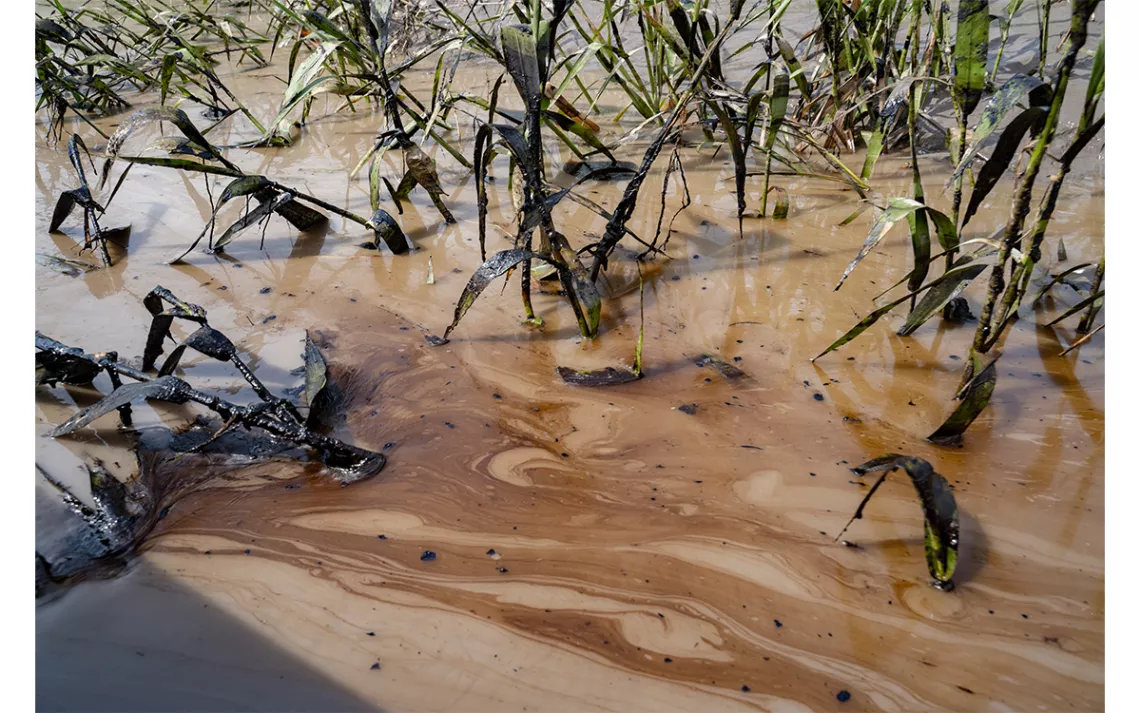
Evidence of the oil spill in the river near the Indigenous communities of Amarunmesa and San Carlos, April 10, 2020.
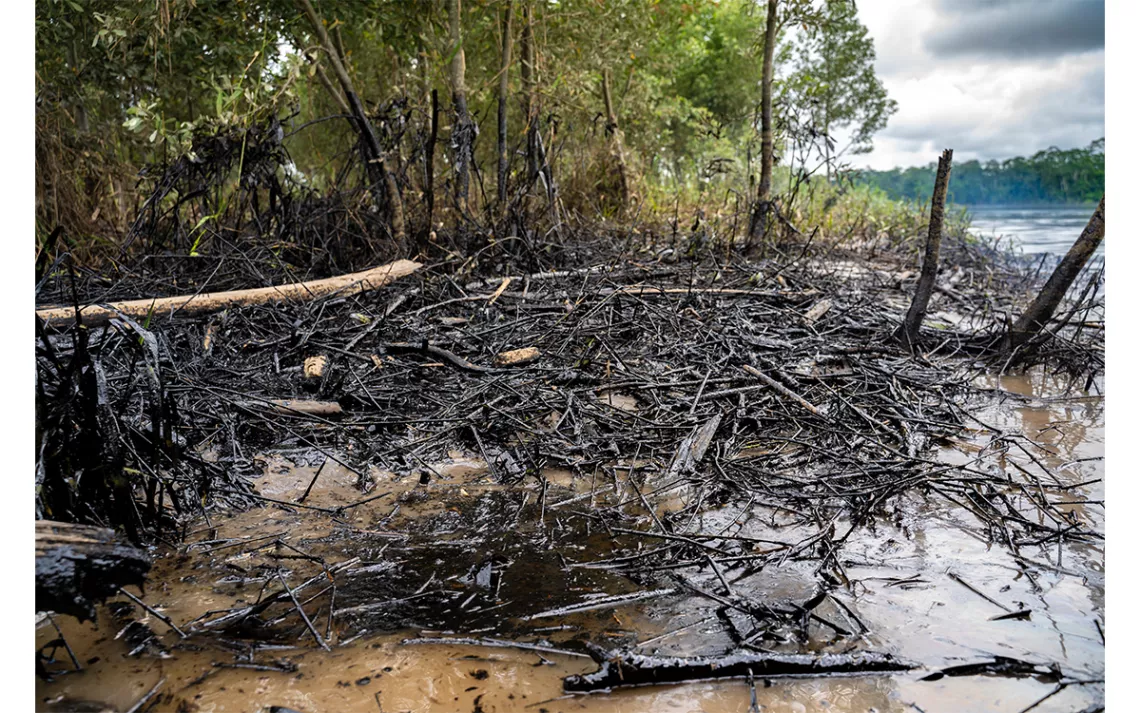
Crude oil on the banks of the river near the city of Coca, northern Ecuadorian Amazon, April 10, 2020.
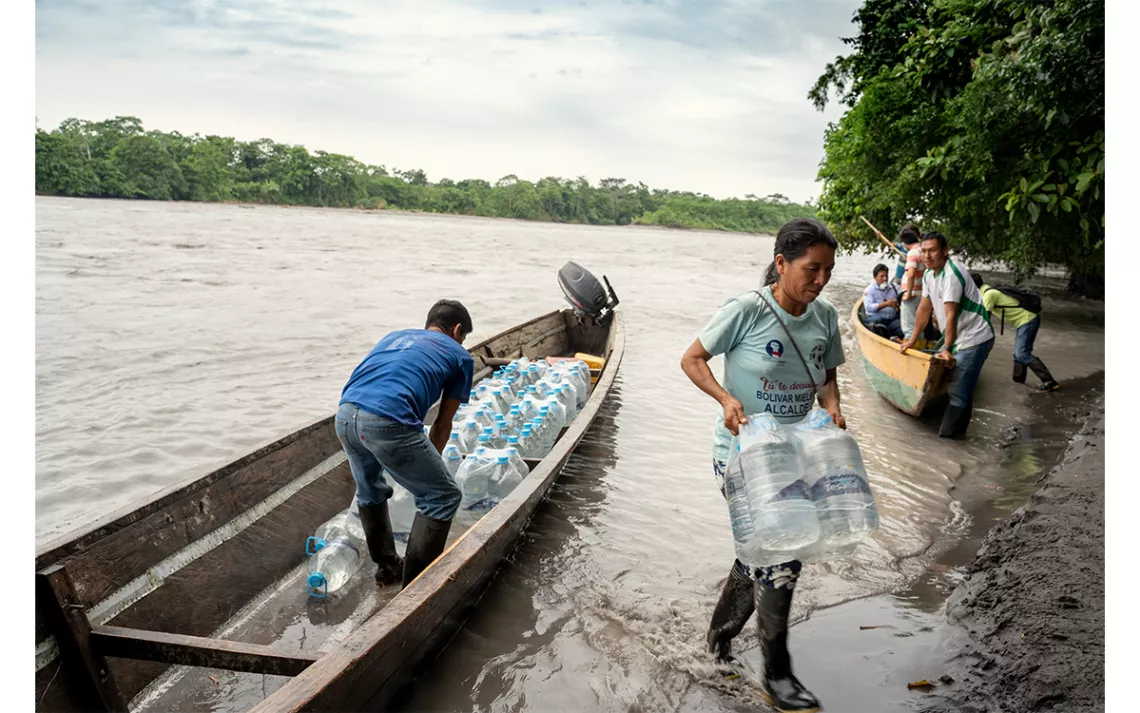
Indigenous community members carry water packs in the wake of the oil spill affecting their river and territory, northern Ecuadorian Amazon, April 18, 2020.
*
During the 2001 construction of the Heavy Crude Pipeline—which tracks the route of the older Trans-Ecuadorian Pipeline—scientists and environmental groups joined Indigenous protests to warn of the catastrophic risks. Since it began operating, there have been 72 spills along its 300-mile route, which passes seismic faults, river gorges, and active volcanoes on the way from lowland-forest drilling sites to refineries and export facilities on the Pacific coast. Together, the pipelines transport the entirety of Ecuador’s oil production—more than 500,000 barrels per day.
“These spills are part of the business of an oil industry that is predicated on breaking the ecological equilibrium,” says Alberto Acosta, Ecuador’s former Minister of Energy and Mines and the former president of the Constitutional Assembly, a role in which he helped Ecuador become the first country in the world to recognize the legal rights of nature. “Our enormous dependence on extractive industries trumps all social and environmental considerations.”
The recent spill powerfully illustrates the perils of the fabled “resource curse.” Just 10 miles upriver from the site of the pipeline rupture is the Chinese-financed and built Coca Codo Sinclair hydroelectric dam. For years, the dam was just a preposterous idea on paper, one that most believed would never be realized because of the area’s well-known seismic faults and a nearby active volcano that erupted as recently as 1987, causing major pipeline damage to the Trans-Ecuadorian Pipeline.
However, in the wake of the 2008 recession (and after defaulting on a $3 billion International Monetary Fund loan), Ecuador’s then-president Rafael Correa began looking to China for a financial lifeline. The dam was built with a loan of over $2 billion from China’s Export-Import bank, part of a broader $19 billion loan agreement (roughly 80 percent of Ecuador’s oil goes to repaying this enormous high-interest loan). Among other things, the dam provides energy for mining projects overseen by Chinese firms.
The dam got off to a shaky start, literally. At full volume, it shuttered to a stop and caused a massive blackout. Now there are thousands of cracks in the dam infrastructure, likely due to engineering and cost-cutting flaws. Meanwhile, the dam has stripped the river of its sediments and caused a kind of river-climate feedback loop known as “hungry waters” where the river pulls sediments from the banks and underneath the mountains. Geologists and hydrologists warned about massive erosion along the Coca River when the San Rafael waterfall—one of Ecuador's tallest and most spectacular falls—began to disappear this past winter. For years, the Chinese-government-funded hydroelectric dam has been depleting the Coca River’s current and accelerating soil erosion under the pipelines that burst.
In February, Emilio Cobo, an environmental scientist with the International Union for the Conservation of Nature, told Antonio Paz of Mongabay that all infrastructure along the Coca River could suffer “extremely severe” impacts if the upstream erosion was not mitigated. After learning of the spill on April 7, Cobo said, “We said this would happen and nothing was done.”
Long before the San Rafael waterfall began to dry up, environmentalists had been warning that the Sinclair dam could threaten precisely this section of the river. Still, the project was approved. As The New York Times reported at the time, “Nearly every top Ecuadorean official involved in the dam’s construction is either imprisoned or sentenced on bribery charges.”
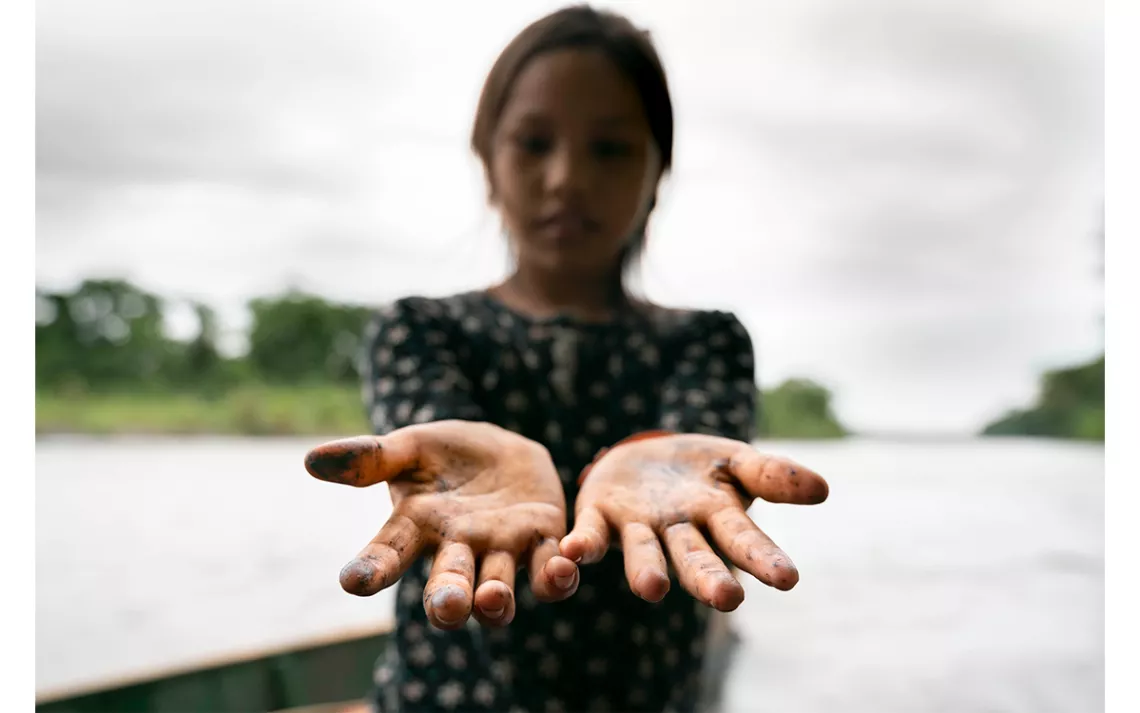
An Indigenous girl’s hands are stained from crude oil after playing along the riverbanks near the community of San Pedro de Río Coca, northern Ecuadorian Amazon, April 18, 2020.
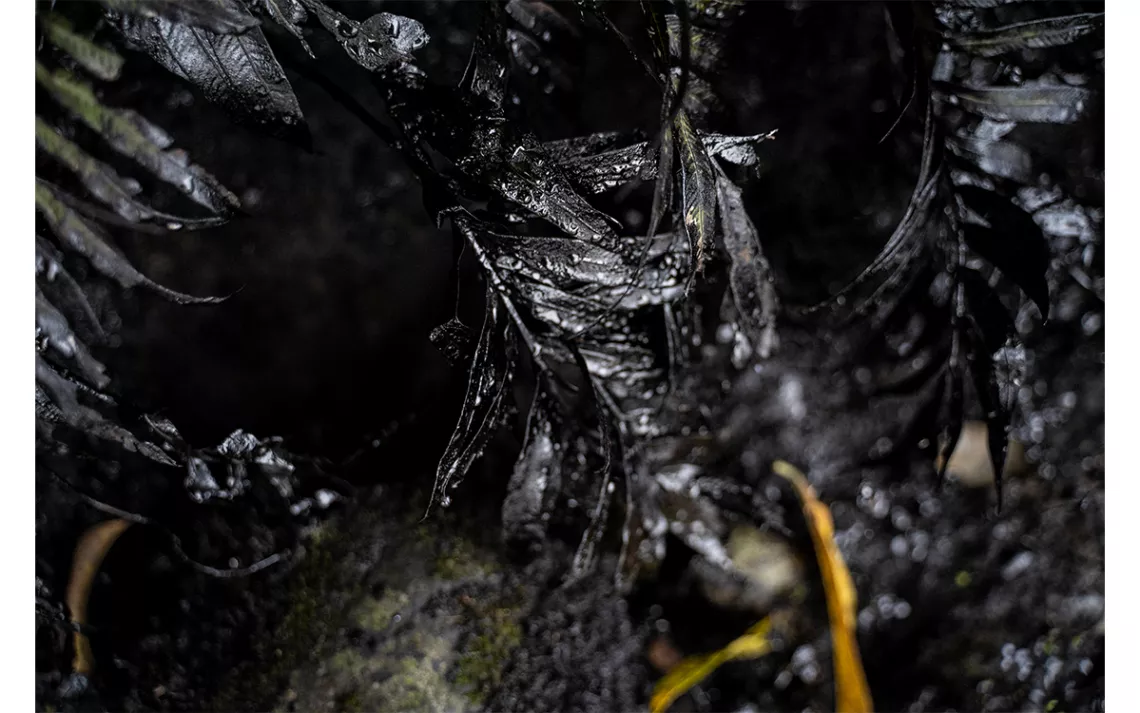
Evidence of contamination in the forest at the Indigenous community of San Pedro de Río Coca, northern Ecuadorian Amazon, April 18, 2020.
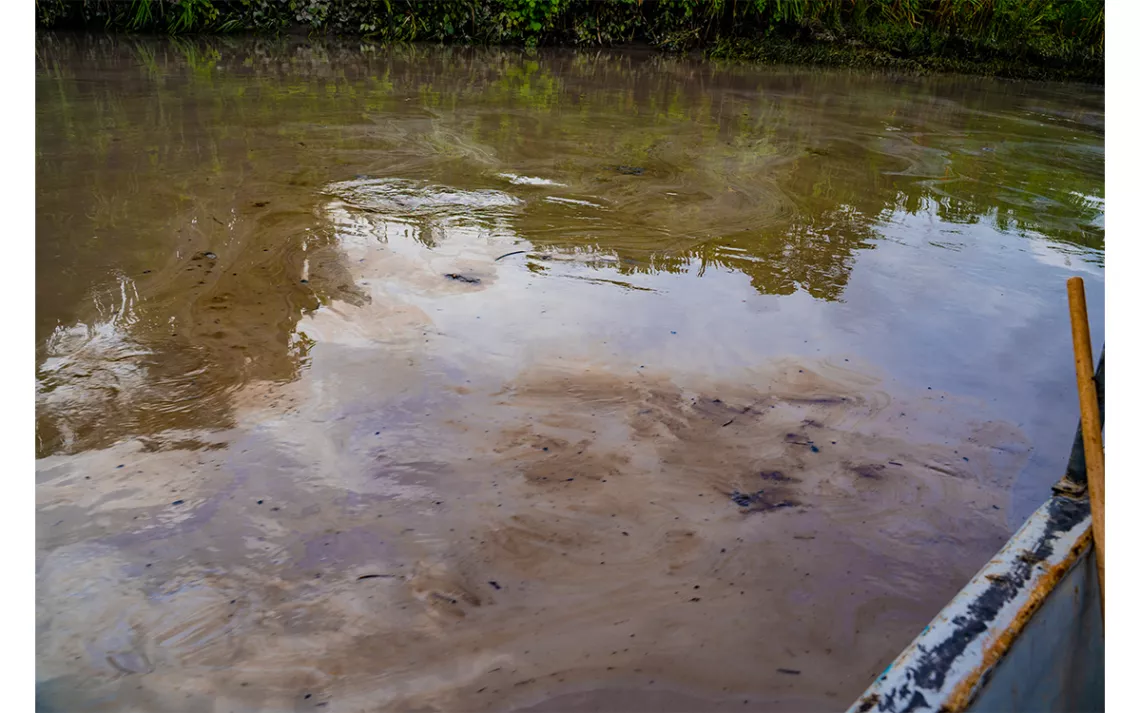
*
Nearly two weeks after the pipeline rupture, the villagers of San Pedro de Río Coca, a subsistence-based Kichwa community about 50 miles downriver from the site of the spill, are struggling to manage the overlapping crises.
“The oil spill flooded our gardens and is sweeping across the islands where our food is planted,” says Edgar Alvarado. “Our food is rotting. The manioc is rotting. It’s turning yellow and dying. There is nowhere to fish. But we are very afraid of leaving our village because we don’t want to get sick and bring the virus back with us.”
Stripped of their traditional food resources, many villagers are nonetheless making the perilous journey to town to buy essential food provisions, raising the awful question of what will happen if an outbreak of COVID-19 occurs in the villages.
Ecuador has been hard hit by COVID-19. The threat is being felt across the Ecuadorian Amazon; the images of corpses abandoned on sidewalks in the cities have caused shudders across Indigenous communities, which have a long history of being decimated by diseases brought by outsiders.
There are echoes of this history in the danger posed by hundreds of oil workers from towns and cities whom the government has recently sent to stop the flow of oil into the river. While it is urgent they work to contain the spill, their presence increases the risk of COVID-19 exposure for Indigenous peoples in their territories.
The response by the oil companies and the government has been woefully inadequate, limited to providing small amounts of food and water to communities along the oil roads. Villages that are only accessible by river have been left to fend for themselves. The communities are working with regional Indigenous federations and human rights organizations to prepare a legal action that would force the government to take stronger and swifter action.
“The government is giving us a couple gallons of water, but that’s not enough for our families,” says Camilo Grefa, former president of the community of San Pedro. “We even have to bathe with the water that the government gives us, because we can’t go into the river.”
This double-crisis in the Ecuadorian Amazon is much more than a local tragedy. The affected Indigenous communities risk their lives every day to protect their territories from the extractive industry and other forest-destroying activity. Because the rainforest plays such a large role in maintaining the planetary climate, protecting the forests’ frontline defenders is crucial to any serious climate mitigation strategy.
“We know that oil is not the future,” says Carlos Jipa. “It brings devastation to our communities and to our rainforest. What will be left when the oil is gone?”
 The Magazine of The Sierra Club
The Magazine of The Sierra Club



